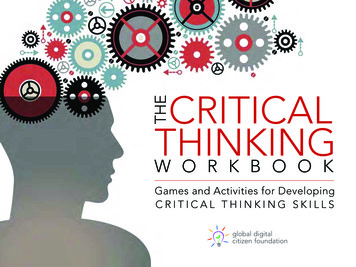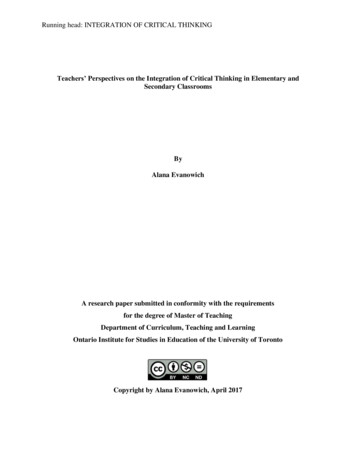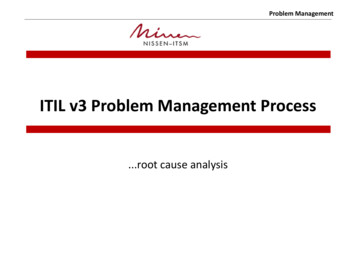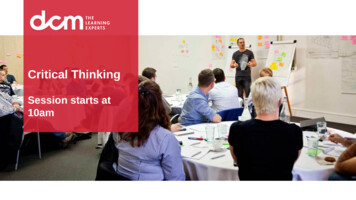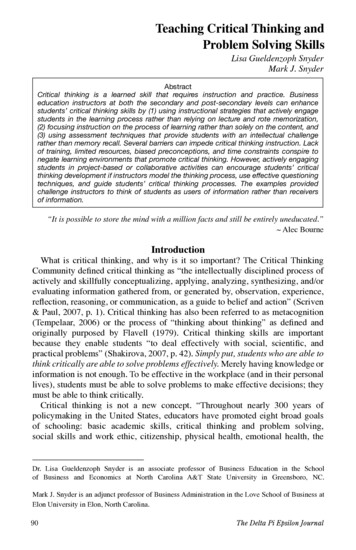
Transcription
Teaching Critical Thinking andProblem Solving SkillsLisa Gueldenzoph SnyderMark J. SnyderAbstractCritical thinking is a learned skill that requires instruction and practice. Businesseducation instructors at both the secondary and post-secondary levels can enhancestudents’ critical thinking skills by (1) using instructional strategies that actively engagestudents in the learning process rather than relying on lecture and rote memorization,(2) focusing instruction on the process of learning rather than solely on the content, and(3) using assessment techniques that provide students with an intellectual challengerather than memory recall. Several barriers can impede critical thinking instruction. Lackof training, limited resources, biased preconceptions, and time constraints conspire tonegate learning environments that promote critical thinking. However, actively engagingstudents in project-based or collaborative activities can encourage students’ criticalthinking development if instructors model the thinking process, use effective questioningtechniques, and guide students’ critical thinking processes. The examples providedchallenge instructors to think of students as users of information rather than receiversof information.“It is possible to store the mind with a million facts and still be entirely uneducated.” Alec BourneIntroductionWhat is critical thinking, and why is it so important? The Critical ThinkingCommunity defined critical thinking as “the intellectually disciplined process ofactively and skillfully conceptualizing, applying, analyzing, synthesizing, and/orevaluating information gathered from, or generated by, observation, experience,reflection, reasoning, or communication, as a guide to belief and action” (Scriven& Paul, 2007, p. 1). Critical thinking has also been referred to as metacognition(Tempelaar, 2006) or the process of “thinking about thinking” as defined andoriginally purposed by Flavell (1979). Critical thinking skills are importantbecause they enable students “to deal effectively with social, scientific, andpractical problems” (Shakirova, 2007, p. 42). Simply put, students who are able tothink critically are able to solve problems effectively. Merely having knowledge orinformation is not enough. To be effective in the workplace (and in their personallives), students must be able to solve problems to make effective decisions; theymust be able to think critically.Critical thinking is not a new concept. “Throughout nearly 300 years ofpolicymaking in the United States, educators have promoted eight broad goalsof schooling: basic academic skills, critical thinking and problem solving,social skills and work ethic, citizenship, physical health, emotional health, theDr. Lisa Gueldenzoph Snyder is an associate professor of Business Education in the Schoolof Business and Economics at North Carolina A&T State University in Greensboro, NC.Mark J. Snyder is an adjunct professor of Business Administration in the Love School of Business atElon University in Elon, North Carolina.90The Delta Pi Epsilon Journal
Teaching Critical Thinking and Problem Solving Skillsarts and literature, and preparation for skilled employment” (Rothstein, Wilder,& Jacobsen, 2007, p. 8). Business education directly addresses work ethic andthe preparation for skilled employment as well as critical thinking and problemsolving. Yet many teachers continually struggle to engage students in criticalthinking activities (Tempelaar, 2006), and students seldom use critical thinkingskills to solve complex, real-world problems (Bartlett, 2002; Rippin, Booth,Bowie, & Jordan, 2002). Why?The answer may be in our instructional methods. Two quotes that are often citedtogether reflect this supposition (as cited by Schafersman, 1991). First, Clement(1979) stated that “we should be teaching students how to think. Instead, we areteaching them what to think” (p. 1). Second, Norman (1981) noted that “it isstrange that we expect students to learn, yet seldom teach them anything aboutlearning” (p. 1). Although content is important, the process of how students learnthe material is equally important. Therefore, the purpose of this article is to analyzeand synthesize secondary research to provide best practices for incorporatingcritical thinking instructional methods into business education classrooms at boththe secondary and post-secondary levels. First, critical thinking is described asit relates to instructional design. Then barriers to critical thinking are outlined.Finally, instructional strategies for enhancing students’ critical thinking skills areprovided as well as examples of critical thinking in business education.How Critical Thinking Relates to Instructional DesignThose who have the ability to hear, do not always actively listen.Similarly, those who have the ability to know, do not always critically think.The premise that critical thinking is to knowing as listening is to hearing impliesthat critical thinking is a learned skill that must be developed, practiced, andcontinually integrated into the curriculum to engage students in active learning.To support this premise, focused attention needs to be placed on the application ofcontent, the process of learning, and methods of assessment.In terms of the application of content, teaching techniques that promotememorization (often temporary knowledge) do not support critical thinking.Although some content, such as vocabulary definitions, do require memory, it isthe application of the content that stimulates thinking. Instruction that supportscritical thinking uses questioning techniques that require students to analyze,synthesize, and evaluate information to solve problems and make decisions (think)rather than merely to repeat information (memorize). Because critical thinkingis a mental habit that requires students to think about their thinking and aboutimproving the process, it requires students to use higher-order thinking skills –not memorize data or accept what they read or are told without critically thinkingabout it (Scriven & Paul, 2008; Schafersman, 1991; Templeaar, 2006). Therefore,critical thinking is a product of education, training, and practice.To link critical thinking skills to content, the instructional focus should be on theprocess of learning. How will the students get the information? Research supportsthe premise that lecture and memorization do not lead to long-term knowledgeVolume L, No. 2, Spring/Summer, 2008.91
LISA GUELDENZOPH SNYDER and Mark J. Snyderor the ability to apply that knowledge to new situations (Celuch & Slama, 1999;Daz-Iefebvre, 2004; Kang & Howren, 2004). Traditional instructional methodsuse too many facts and not enough conceptualization; too much memorizing andnot enough thinking. Therefore, lecture and rote memorization do not promotecritical thinking. Instructional strategies that employ students’ higher-orderthinking skills lead to improved critical thinking skills ( Duplass & Ziedler, 2002;Hemming, 2000; Wong, 2007).Additionally, assessments should emphasize thinking rather than facts(Ennis, 1993). Graded assignments, quizzes, or tests should become intellectualchallenges rather than memory recall (Schafersman, 1991). Subjective tools suchas essay questions and case studies require students to apply their knowledge tonew situations and are better indicators of understanding than objective true/falseor standardized multiple-choice assessments. However, instructors can createmultiple-choice questions that require critical thinking. For example, a questionthat asks students to identify the example that best applies a specific conceptrequires more critical thinking and analysis than a question that asks students toidentify the correct term for a given definition. Ennis stated that although they aremore labor intensive to create than equally effective open-ended critical thinkingassessments, multiple-choice tests are easier to grade. To enhance students’processing skills, it is important to review test questions and explain correctanswers by modeling the critical thinking process (Brown & Kelly, 1986; Duplass& Ziedler, 2002; Schafersman, 1991).Barriers to Critical ThinkingSeveral researchers (Landsman & Gorski, 2007; Sandholtz, Ogawa, & Scribner,2004; Sheldon & Biddle, 1998; Wong, 2007) suggest that the current educationaltrend to standardize curricula and focus on test scores undermines instructors’ability to address critical thinking in the classroom. The emphasis on “teachingto the test” distracts the learning process from student-centered instruction andplaces the emphasis on the content. If the focus is on learning, students should begiven the freedom (and responsibility) to explore content, analyze resources, andapply information.Unfortunately, students are not typically taught to think or learn independently,and they rarely “pick up” these skills on their own (Ladsman & Gorski, 2007;Lundquist, 1999; Rippen, Booth, Bowie, & Jordan, 2002). Critical thinking isnot an innate ability. Although some students may be naturally inquisitive, theyrequire training to become systematically analytical, fair, and open-minded in theirpursuit of knowledge. With these skills, students can become confident in theirreasoning and apply their critical thinking ability to any content area or discipline(Lundquist, 1999). Critical thinking is often compared to the scientific method;it is a systematic and procedural approach to the process of thinking (Scriven &Paul, 2007). Just as students learn the process of the scientific method, they mustalso learn the process of critically thinking.Four barriers often impede the integration of critical thinking in education:(1) lack of training, (2) lack of information, (3) preconceptions, and (4) time92The Delta Pi Epsilon Journal
Teaching Critical Thinking and Problem Solving Skillsconstraints. First, teachers often are not trained in critical thinking methodology(Broadbear, 2003). Elementary and secondary teachers know their content andreceive training in the methods of instruction, but little if any of their trainingis devoted specifically to how to teach critical thinking skills. Post-secondaryinstructors pursue additional content-based instruction during graduate school, butoften have no formal methodological training, much less skill-based instruction.Second, few instructional materials provide critical thinking resources (Scriven &Paul, 2007). Some textbooks provide chapter-based critical thinking discussionquestions, but instructional materials often lack additional critical thinkingresources.Third, both teachers and students have preconceptions about the contentthat blocks their ability to think critically about the material. Preconceptionssuch as personal bias partiality prohibit critical thinking because they obviateanalytical skills such as being fair, open-minded, and inquisitive about a topic(Kang & Howren, 2004). For example, many business educators still continueusing two spaces after ending punctuation even though typeface experts havedocumented that today’s proportional fonts are designed for one space (AmericanPsychological Association, 2001, pp. 290–291; Chicago Manual of Style Online,2007). A critical analysis of the information provided on this typesetting topicwould support the use of a single space; however, strong biases for two spacespreclude many business teachers (predominantly typing teachers) from changingtheir opinion and adopting the acceptable procedure.Finally, time constraints are barriers to integrating critical thinking skills in theclassroom. Instructors often have a great deal of content to cover within a shorttime period. When the focus is on content rather than student learning, shortcutssuch as lectures and objective tests become the norm. Lecturing is faster and easierthan integrating project-based learning opportunities. Objective tests are faster totake (and grade) than subjective assessments. However, research indicates thatlecturing is not the best method of instruction, and objective tests are not the bestmethod of assessment (Broadbear, 2003; Brodie & Irving, 2007).Instructional Strategies for IntegratingCritical Thinking SkillsEven when the typical barriers are overcome, critical thinking requires morethan simple engagement. It involves students’ personal discovery of information.In a study investigating students’ learning (Nokes, Dole, & Hacker, 2007), studentswho used heuristic techniques to solve problems consistently scored higher oncontent-based assessments than students who learned by traditional textbook andlecture methods. Heuristic teaching methods encourage students to “learn, discover,understand, or solve problems on [their] own, as by experimenting, evaluatingpossible answers or solutions, or by trial and error” (Dictionary.com, 2007, p.1). A similar study suggested that problem-based learning activities promoted“critical thinking and problem-solving skills; active participation in the learningprocess including self-direction, identification of own learning needs, teamwork,creative discussion, and learning from peers; and the integration and synthesisVolume L, No. 2, Spring/Summer, 2008.93
LISA GUELDENZOPH SNYDER and Mark J. Snyderof a variety of knowledge” (Gurses, Acikyildiz, Dogar, & Sozbilir, 2007, p. 1).Kumar and Natarajan (2007) also found problem-based learning environmentsto increase students’ thinking skills and knowledge acquisition. A comparableconcept is work-based learning. As noted by Brodie and Irving (2007), workbased learning (WBL) “is based on the inter-relationship and inter-dependencybetween understanding learning, critical reflection and the identification anddevelopment of capability within a WBL context” (p. 11).Many business education researchers have addressed critical thinking. Rippinet al. (2002) investigated the use of case study methods in undergraduate businesseducation courses. Braun (2004) focused on improving critical thinking methodsin business education curriculum development. Celuck and Slama (1999)identified methods of integrating critical thinking skills into business courses.Other researchers (Catanach, Croll, & Grinaker, 2000; Saraoghu, Yobaccio, &Louton, 2000) studied hands-on activities that required students to think criticallyand apply their knowledge to specific tasks. In nearly all studies that suggestedmethods for integrating critical thinking skills, the elements of modeling,questioning, and guiding student practice were emphasized.Modeling Critical Thinking SkillsAlthough business education students perceive critical thinking as an importantskill (Davis, Riley, & Fisher, 2003), they typically do not know how to thinkcritically. Students are not born with the ability to think critically, and their priorlearning experiences often do not require them to think critically. Therefore,instructors who wish to integrate this skill in their classroom experiences mustfirst model the behavior (Hemming, 2000). Students must learn how to thinkcritically before they can apply the skill to content scenarios. Modeling can bedemonstrated in a discussion setting by asking a question and “walking studentsthrough” the process of critically thinking.Further, critical thinking activities should be based on a structure that includesfour elements: “ill-structured problems, criteria for assessing thinking, studentassessment of thinking, and improvement of thinking” (Broadbear, 2003, p. 7).Ill-structured problems are questions, case studies, or scenarios that do not have adefinite right or wrong answer; they include debatable issues that require “reflectivejudgment.” For example, asking students to evaluate comparable websites, suchas Wal-Mart and Target, requires them to think about the content of the websites,their format, and their usability. Right and wrong answers do not exist as long asthe student’s choice is supported by logical reasoning.The second element, criteria for assessing thinking, provides students with aframework for thinking about their thinking. Why do you think Target’s navigationalmenus are easier to use than Wal-Mart’s? Why do you like one’s color schemeover the other? What is your perspective based upon? Providing students withindividualized feedback based on their responses allows them to address specificcriteria upon which they can assess their thinking, which is the third element. Ifinstructors model the criteria for assessing thinking and provide a framework,students will eventually apply these techniques on their own (Lundquist, 1999).94The Delta Pi Epsilon Journal
Teaching Critical Thinking and Problem Solving SkillsFinally, the process concludes with improvement of thinking. By creating aculture of inquiry where students can think about their thinking processes andpractice logical constructs, students will become more willing to reconsider andrevise their thinking (Duplass & Ziedler, 2002).Questioning TechniquesIn their research, Haynes and Bailey (2003) emphasized the importance of askingthe right questions to stimulate students’ critical thinking skills. Other researchers(Brown & Kelley, 1986; Hemming, 2000) also focused on integrating questioningtechniques into class discussions to support an educational environment wherestudents can demonstrate and practice critical thinking skills. Brown and Kelley’sbook, Asking the Right Questions: A Guide to Critical Thinking, documented thepremise that students’ critical thinking is best supported when instructors usecritical questioning techniques to engage students actively in the learning process.Sample questions from all these studies include the following: What do you think about this? Why do you think that? What is your knowledge based upon? What does it imply and presuppose? What explains it, connects to it, leads from it? How are you viewing it? Should it be viewed differently?These questions require students to evaluate the clarity and accuracy of theirthinking as well as the depth and breadth of their thinking. Have they consideredall the alternatives? Do they know why they think the way they do? Students needto determine whether the content they are using is relevant and if their thinkingprocess is logical. By questioning their thought process, students can beginthinking about their thinking.Research on questioning methodology also suggests that instructors shouldwait for student responses (Brown & Kelley, 1986; Hemming, 2000). Too often,the students’ silence is filled by the instructor re-wording the question or askinga different student for a response. However, most students need at least 8 to 12seconds to process and formulate their response, especially in critical thinkingsituations (Schafersman, 1991). If a question is based on rote memory recall, speedmay be relevant; however, thinking requires time and patience. Give students thetime they need to think critically.Research also provides strategies for using questioning methods in onlinelearning environments (Astleitner, 2002; MacKnight 2000). Discussion boards,virtual chat rooms, and instant messages provide forums for questioning andcritical thinking. In synchronous environments, instructors can question studentsas they construct their responses. Although this is not possible with asynchronouscommunication, instructors can model the critical thinking process and assignactivities that utilize questioning techniques and critical thinking responses. Inall learning environments, it is important to guide students through the criticalthinking process.Volume L, No. 2, Spring/Summer, 2008.95
LISA GUELDENZOPH SNYDER and Mark J. SnyderGuiding Students’ Critical ThinkingWhen students are accustomed to being passive learners by merely memorizingand recalling information, it may be difficult at first to engage them in activelearning situations that require critical thinking skills (Brown & Kelley, 1986).Instructors should be aware of students’ initial resistance and guide them throughthe process to create a learning environment where students feel comfortablethinking through an answer rather than simply having an answer. For example,peer coaching techniques can engage students in active learning and criticalthinking opportunities (Ladyshewsky, 2006). Assign students to two-personteams; one student is the problem-solver, and the other is the peer coach. Usingthe Six Steps to Effective Thinking and Problem Solving, or “IDEALS” (Facione,2007), the problem-solver works through a case study or activity by responding toquestions from the peer coach. The IDEALS are to Identify, Define, Enumerate,Analyze, List, and Self-Correct:I Identify the Problem: What is the real question we are facing?DDefine the Context: What are the facts that frame this problem?EEnumerate the Choices: What are plausible options?AAnalyze Options: What is the best course of action?L List Reasons Explicitly: Why is this the best course of action?S Self-Correct: Look at it again What did we miss?This problem-solving technique guides students through the critical thinkingprocess and utilizes learner collaboration. Similar strategies include integratingproject-based learning activities that require students to apply their knowledgeby constructing a real-world product. As a final guide to student practice, usepeer assessments to facilitate students’ critical thinking and meta-cognitive skills(Hou, Chang, & Sung, 2007).Examples of Critical Thinking in Business EducationMany critical thinking strategies have been used successfully in businesseducation courses at all levels. At the secondary level, Bartlett (2002) found thathigh school business students ranked critical thinking as the highest cognitivestrategy. Shakirova (2007) analyzed the use of technology to support upper-gradestudents’ critical thinking skills.At the university level, Tempelaar (2006) investigated the role of critical thinkingin business education programs and found a positive correlation between criticalthinking (identified as a subset of metacognition skills) and course performance.Hannon, McBride, and Burns (2004) developed a critical thinking module inan undergraduate business studies program that used experiential exercises toenhance students’ decision-making and conflict resolution skills.Most research focused on collaborative learning activities to develop students’critical thinking skills (Yazici, 2004). For example, Ngai (2007) documented usinga project-based team approach for an undergraduate e-commerce activity. Resultsfrom both student surveys and assessments indicated that students gained criticalthinking skills based on the practical application of “learning-by-doing” and thecollaborative effort required by the project. Dudley, Davis, and McGrady (2001)96The Delta Pi Epsilon Journal
Teaching Critical Thinking and Problem Solving Skillsalso reported students’ use of critical thinking skills when accounting studentscompleted a group project involving the hypothetical creation of stock portfolios.A similar result was found when Whatley and Dyck (2000) applied InternationalMonetary Fund development scenarios to international business topics with MBAstudents. The case method was also used by Rippen, et al. (2002) to providestudents with the experience of practicing intervention skills and solving complexproblems. With a little investigation and creativity, instructors can find resourcesthat facilitate the integration of critical thinking activities into their courses.ConclusionThe goal for business educators who want to instill critical thinking skills intheir classrooms is to think of their students not as receivers of information, butas users of information. Learning environments that actively engage students inthe investigation of information and the application of knowledge will promotestudents’ critical thinking skills. However, as with any skill, critical thinkingrequires training, practice, and patience. Students may initially resist instructionalquestioning techniques if they previously have been required only to rememberinformation and not think about what they know. They may struggle withassessment questions that are not taken verbatim from the book. However, byencouraging students throughout the process and modeling thinking behaviors,students’ critical thinking skills can improve. The effort is worth the reward:students who can critically think for themselves and solve real-world problems.ReferencesAmerican Psychological Association (2001). Publication manual of the AmericanPsychological Association, 5th edition. Washington, DC: American Psychological Association.Astleitner, H. (2002). Teaching critical thinking online. Journal of InstructionalPsychology, 29(2), 53–77.Bartlett, J. E. (2002). Analysis of motivational orientation and learning strategiesof high school business students. Business Education Forum, 56(4), 18–23.Braun, N. M. (2004). Critical thinking in the business curriculum. Journal ofEducation for Business, 70(4), 232–236.Broadbear, J. T. (2003). Essential elements of lessons designed to promote criticalthinking. Journal of Scholarship of Teaching and Learning, 3(3), 1–8.Brodie, P., & Irving, K. (2007). Assessment in work-based learning: Investigating apedagogical approach to enhance student learning. Assessment & Evaluationin Higher Education, 32(1), 11–19.Brown, M. N., & Kelley, S. M. (1986). Asking the right questions: A guide tocritical thinking, 7th ed. Englewood Cliffs, NJ: Prentice Hall.Catanach, A. H., Croll, D. B., & Grinaker, R. L. (2000). Teaching intermediatefinancial accounting using a business activity model. Issues in AccountingEducation, 15(4), 583.Volume L, No. 2, Spring/Summer, 2008.97
LISA GUELDENZOPH SNYDER and Mark J. SnyderCeluch, K., & Slama, M. (1999). Teaching critical thinking skills for the 21stcentury: An advertising principles case study. Journal of Education forBusiness, 74(3), 134.Chicago Manual of Style Online (2007). Retrieved January 2, 2008, from nt, J. (1979). Introduction to research in cognitive process instruction. InLochhead, J. and Clement, J. (Eds.), Cognitive process instruction. Hillsdale,NJ: Lawrence Erlbaum Associates.Davis, L., Riley, M., & Fisher, D. J. (2003). Business students’ perceptions ofnecessary skills. Business Education Forum, 57(4), 18–21.Daz-Iefebvre, R. (2004). Multiple intelligences, learning for understanding, andcreative assessment: Some pieces to the puzzle of learning. Teachers CollegeRecord, 106(1), 49–57.Dictionary.com (2007). Lexico Publishing Group, LLC, Retrieved January 2,2008, from http://www.dictionary.comDudley, L. W., Davis, H. H., & McGrady, D. G. (2001). Using an investmentproject to develop professional competencies in introduction to financialaccounting. Journal of Education for Business, 76(3), 125–131.Duplass, J. A., & Ziedler, D. L. (2002). Critical thinking and logical argument.Social Education, 66(5), 10–14.Ennis, R. H. (1993). Critical thinking assessment. Theory Into Practice, 32(3),179–186.Facione, P. A. (2007). Critical thinking: What it is and why it counts. RetrievedJanuary 2, 2008, from ng7.htmFlavell, J. H. (1979). Metacognition and cognitive monitoring: A new area ofcognitive-development inquiry. American Psychologist, 34, 906–911.Gurses, A., Acikyildiz, M., Dogar, C., & Sozbilir, M. (2007). An investigationinto the effectiveness of problem-based learning in a physical chemistrylaboratory course. Research in Science & Technological Education, 25(1),99–113.Hannon, S., McBride, H., & Burns, B. (2004). Developing creative and criticalthinking abilities in business graduates: The value of experiential learningtechniques. Industry and Higher Education, 18(2), 95–100.Haynes, T., & Bailey, G. (2003). Are you and your basic business students askingthe right questions? Business Education Forum, 57(3), 33–37.Hemming, H. E. (2000). Encouraging critical thinking: “But what does thatmean?” Journal of Education, 35(2), 173.Hou, H., Chang, K., & Sung, Y. (2007). An analysis of peer assessment onlinediscussions within a course that uses project-based learning. InteractiveLearning Environments, 15(3), 237–251.Kang, N., & Howren, C. (2004). Teaching for conceptual understanding. Scienceand Children, 42(1), 28–32.Kumar, M., & Natarajan, U. (2007). A problem-based learning model: Showcasingan educational paradigm shift. Curriculum Journal, 18(1), 89–102.98The Delta Pi Epsilon Journal
Teaching Critical Thinking and Problem Solving SkillsLadyshewsky, R. K. (2006). Peer coaching: A constructivist methodology forenhancing critical thinking in postgraduate business education. HigherEducation Research and Development, 25(1), 67–84.Landsman, J., & Gorski, P. (2007). Countering standardization. EducationalLeadership, 64(8), 40–41.Lundquist, R. (1999). Critical thinking and the art of making good mistakes.Teaching in Higher Education, 4(4), 523–530.MacKnight, C. B. (2000). Teaching critical thinking through online discussions.Educause Quarterly, 23(4), 38–41.Ngai, E. W. T. (2007). Learning in introductory e-commerce: A project-basedteamwork approach. Computers and Education, 48(1), 17–29.Nokes, J. D., Dole, J. A., & Hacker, D. J. (2007). Teaching high school studentsto use heuristics while reading historical texts. Journal of EducationalPsychology, 99(3), 492–504.Norman, D. A. (Ed.) (1981). Perspectives on cognitive science. Hillsdale, NJ:Erlbaum.Rippen, A., Booth, C., Bowie, S., & Jordan, J. (2002). A complex case: Using thecase study method to explore uncertainty and ambiguity in undergraduatebusiness education. Teaching in Higher Education, 7(4), 429.Rothstein, R., Wilder, T., & Jacobsen, R. (2007). Balance in the balance.Educational Leadership, 52(8), 8–14.Sandholtz, J. H., Ogawa, R. T., & Scribner, S. P. (2004). Standards gaps:Unintended consequences of local standards-based reform. Teachers CollegeRecord, 106(6), 1177–1202.Saraoghu, H., Yobaccio, E.,
of schooling: basic academic skills, critical thinking and problem solving, social skills and work ethic, citizenship, physical health, emotional health, the Dr. Lisa Gueldenzoph Snyder is an associate professor of Business Education in the School of Business and Economics at N



